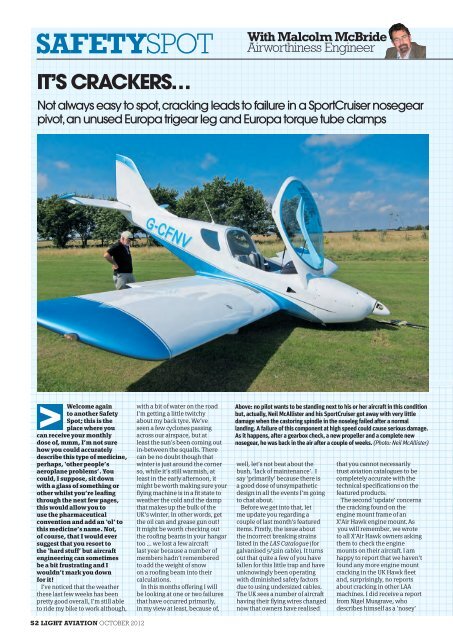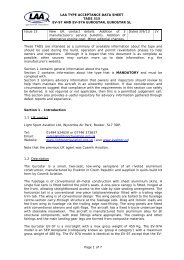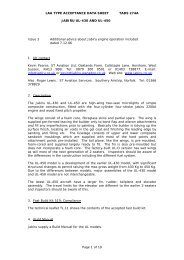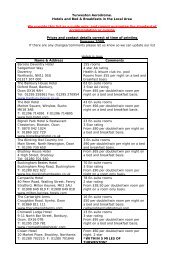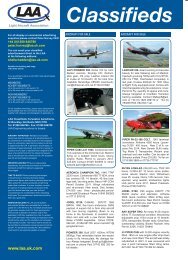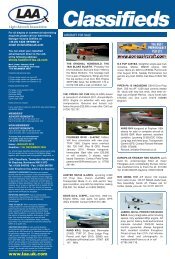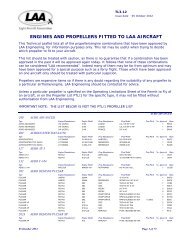LA.oct - Safety spot.v6.IW.indd - the Light Aircraft Association
LA.oct - Safety spot.v6.IW.indd - the Light Aircraft Association
LA.oct - Safety spot.v6.IW.indd - the Light Aircraft Association
You also want an ePaper? Increase the reach of your titles
YUMPU automatically turns print PDFs into web optimized ePapers that Google loves.
SAFETYSPOT<br />
IT’S CRACKERS…<br />
Welcome again<br />
to ano<strong>the</strong>r <strong>Safety</strong><br />
Spot; this is <strong>the</strong><br />
place where you<br />
can receive your monthly<br />
dose of, mmm, I’m not sure<br />
how you could accurately<br />
describe this type of medicine,<br />
perhaps, ‘o<strong>the</strong>r people’s<br />
aeroplane problems’. You<br />
could, I suppose, sit down<br />
with a glass of something or<br />
o<strong>the</strong>r whilst you’re leafi ng<br />
through <strong>the</strong> next few pages,<br />
this would allow you to<br />
use <strong>the</strong> pharmaceutical<br />
convention and add an ‘ol’ to<br />
this medicine’s name. Not,<br />
of course, that I would ever<br />
suggest that you resort to<br />
<strong>the</strong> ‘hard stuff’ but aircraft<br />
engineering can sometimes<br />
be a bit frustrating and I<br />
wouldn’t mark you down<br />
for it!<br />
I’ve noticed that <strong>the</strong> wea<strong>the</strong>r<br />
<strong>the</strong>se last few weeks has been<br />
pretty good overall, I’m still able<br />
to ride my bike to work although,<br />
52 LIGHT LIGHT AVIATION AVIATION MAY2011 OCTOBER 2012<br />
with a bit of water on <strong>the</strong> road<br />
I’m getting a little twitchy<br />
about my back tyre. We’ve<br />
seen a few cyclones passing<br />
across our airspace, but at<br />
least <strong>the</strong> sun’s been coming out<br />
in-between <strong>the</strong> squalls. There<br />
can be no doubt though that<br />
winter is just around <strong>the</strong> corner<br />
so, while it’s still warmish, at<br />
least in <strong>the</strong> early afternoon, it<br />
might be worth making sure your<br />
fl ying machine is in a fi t state to<br />
wea<strong>the</strong>r <strong>the</strong> cold and <strong>the</strong> damp<br />
that makes up <strong>the</strong> bulk of <strong>the</strong><br />
UK’s winter. In o<strong>the</strong>r words, get<br />
<strong>the</strong> oil can and grease gun out!<br />
It might be worth checking out<br />
<strong>the</strong> roofi ng beams in your hangar<br />
too … we lost a few aircraft<br />
last year because a number of<br />
members hadn’t remembered<br />
to add <strong>the</strong> weight of snow<br />
on a roofi ng beam into <strong>the</strong>ir<br />
calculations.<br />
In this months offering I will<br />
be looking at one or two failures<br />
that have occurred primarily,<br />
in my view at least, because of,<br />
With Malcolm McBride<br />
Airworthiness Engineer<br />
Not always easy to <strong>spot</strong>, cracking leads to failure in a SportCruiser nosegear<br />
pivot, an unused Europa trigear leg and Europa torque tube clamps<br />
Above: no pilot wants to be standing next to his or her aircraft in this condition<br />
but, actually, Neil McAllister and his SportCruiser got away with very little<br />
damage when <strong>the</strong> castoring spindle in <strong>the</strong> noseleg failed after a normal<br />
landing. A failure of this component at high speed could cause serious damage.<br />
As it happens, after a gearbox check, a new propeller and a complete new<br />
nosegear, he was back in <strong>the</strong> air after a couple of weeks. (Photo: Neil McAllister)<br />
well, let’s not beat about <strong>the</strong><br />
bush, ‘lack of maintenance’. I<br />
say ‘primarily’ because <strong>the</strong>re is<br />
a good dose of unsympa<strong>the</strong>tic<br />
design in all <strong>the</strong> events I’m going<br />
to chat about.<br />
Before we get into that, let<br />
me update you regarding a<br />
couple of last month’s featured<br />
items. Firstly, <strong>the</strong> issue about<br />
<strong>the</strong> incorrect breaking strains<br />
listed in <strong>the</strong> <strong>LA</strong>S Catalogue (for<br />
galvanised 5/32in cable). It turns<br />
out that quite a few of you have<br />
fallen for this little trap and have<br />
unknowingly been operating<br />
with diminished safety factors<br />
due to using undersized cables.<br />
The UK sees a number of aircraft<br />
having <strong>the</strong>ir fl ying wires changed<br />
now that owners have realised<br />
that you cannot necessarily<br />
trust aviation catalogues to be<br />
completely accurate with <strong>the</strong><br />
technical specifi cations on <strong>the</strong><br />
featured products.<br />
The second ‘update’ concerns<br />
<strong>the</strong> cracking found on <strong>the</strong><br />
engine mount frame of an<br />
X’Air Hawk engine mount. As<br />
you will remember, we wrote<br />
to all X’Air Hawk owners asking<br />
<strong>the</strong>m to check <strong>the</strong> engine<br />
mounts on <strong>the</strong>ir aircraft. I am<br />
happy to report that we haven’t<br />
found any more engine mount<br />
cracking in <strong>the</strong> UK Hawk fl eet<br />
and, surprisingly, no reports<br />
about cracking in o<strong>the</strong>r <strong>LA</strong>A<br />
machines. I did receive a report<br />
from Nigel Musgrave, who<br />
describes himself as a ‘nosey’
Here’s an undamaged nosewheel fork complete with an intact spindle,<br />
for your reference. Note that <strong>the</strong> spindle itself is welded to a plate<br />
steel frame which is <strong>the</strong>n bolted to <strong>the</strong> fork. This sort of (hand-made)<br />
construction is common in low volume production items; welding will<br />
aff ect <strong>the</strong> materials ability to withstand stress both locally to <strong>the</strong> weld,<br />
because of <strong>the</strong> introduction of stress concentrations and generally,<br />
by changing <strong>the</strong> heat treatment state of <strong>the</strong> material. In this case<br />
<strong>the</strong> material is 4130 Chromoly steel which needs careful pre- and<br />
post-weld heat treatment if <strong>the</strong> original strength is to be maintained.<br />
(Photo: Malcolm McBride)<br />
Sometimes it’s worth<br />
being nosey! Nigel is a<br />
BMAA Inspector who<br />
happened to read last<br />
month’s <strong>Safety</strong> Spot<br />
featuring <strong>the</strong> X’Air<br />
Hawk engine mount<br />
frame cracks. He<br />
decided to take a closer<br />
look at a friend’s Zenair<br />
601HD and just look<br />
at what he saw… Good<br />
<strong>spot</strong> Nigel.<br />
(Photo: Nigel Musgrave)<br />
With Malcolm McBride<br />
Airworthiness Engineer<br />
Left: this picture shows clearly <strong>the</strong> complex nature of this failure – it looks<br />
like a simple fatigue failure with an origin at <strong>the</strong> front of <strong>the</strong> pin (that’s <strong>the</strong><br />
top in this photo). A closer look, however, shows dual origins for <strong>the</strong> crack<br />
and <strong>the</strong>re is a distinct possibility that <strong>the</strong> initial fatigue failure worked from<br />
<strong>the</strong> inside out. This is particularly worrying as a developing crack may not<br />
be inspectable. The strange area at <strong>the</strong> bottom of <strong>the</strong> fracture face has been<br />
caused, we think, by <strong>the</strong> infl uence of <strong>the</strong> surrounding wear plate. The middle<br />
portion is considered to be a failure in overload. (Photo: Malcolm McBride)<br />
BMAA Inspector, who found<br />
some ra<strong>the</strong>r severe wear on <strong>the</strong><br />
engine mount frame of an <strong>LA</strong>A<br />
Zenair CH601HD. Take a look<br />
at <strong>the</strong> picture Nigel sent in<br />
with his report showing <strong>the</strong><br />
damage found.<br />
When you get an isolated<br />
failure, like <strong>the</strong> cracking on <strong>the</strong><br />
X’Air engine mount, it’s always<br />
worth looking at what might be<br />
different on <strong>the</strong> failed example<br />
from a fl eet normal, sometimes<br />
a failure mode is obvious. In<br />
<strong>the</strong> case of <strong>the</strong> X’Air failure I did<br />
receive a number of suggestions<br />
from structural engineers<br />
explaining why <strong>the</strong>y felt <strong>the</strong><br />
cracks had occurred … thanks<br />
to <strong>the</strong>m for putting pen to paper,<br />
I certainly learnt something<br />
about <strong>the</strong> nature of cyclical<br />
loads generated by engines from<br />
<strong>the</strong>ir input!<br />
In this case, <strong>the</strong> ‘difference’<br />
appeared to be that this<br />
particular machine spent a<br />
lot of time on <strong>the</strong> back of a<br />
trailer being transported to<br />
different venues. After a bit<br />
of gentle digging, it turned out<br />
that <strong>the</strong> airframe was tied<br />
down at <strong>the</strong> nose and tail<br />
during transportation and<br />
this may have led to an unusual<br />
load path through <strong>the</strong> engine<br />
frame. The jury is still out over<br />
this but I’m sleeping better<br />
at night now that I know that y<br />
ou are regularly checking<br />
your engine mounts. You are,<br />
aren’t you?<br />
In any event, Francis<br />
Donaldson, <strong>the</strong> <strong>LA</strong>A’s Chief<br />
Engineer, is on <strong>the</strong> case and has<br />
offered some suggestions as to<br />
how it could be streng<strong>the</strong>ned on<br />
future models.<br />
Don’t forget that all past <strong>Safety</strong><br />
Spots are available on <strong>the</strong> <strong>LA</strong>A<br />
website so if you haven’t read<br />
about <strong>the</strong> issues I’ve just been<br />
updating you on, log onto <strong>the</strong><br />
<strong>LA</strong>A website at www.laa.uk.com.<br />
You will fi nd <strong>the</strong> archived <strong>Safety</strong><br />
Spots in <strong>the</strong> Briefi ng Room.<br />
Let’s get on with this month<br />
intrigue…<br />
➽<br />
OCTOBER 2012 LIGHT AVIATION 53
SAFETYSPOT<br />
Here is a picture showing <strong>the</strong> o<strong>the</strong>r end of <strong>the</strong> pin still in place, complete<br />
with mud! You will note that this assembly is normally encased in a spat and<br />
is <strong>the</strong>refore not quite so easily inspected. We recommend that at least every<br />
hundred hours <strong>the</strong> undercarriage should be stripped, cleaned, inspected and<br />
re lubricated. (Photo: Neil McAllister)<br />
The <strong>LA</strong>A produced an AIL requiring checks on SportCruiser nose<br />
undercarriage castoring spindles and <strong>the</strong> above picture was sent to me<br />
by <strong>the</strong> aircraft’s co-owner, Mick Jones. I spoke with Mark Ansty, <strong>the</strong> <strong>LA</strong>A<br />
Inspector who oversaw <strong>the</strong> checks and he explained that he had grounded<br />
<strong>the</strong> aircraft until this part could be replaced. I hope that you will note <strong>the</strong><br />
severe corrosion, not visible without disassembly. (Photo: Mick Jones)<br />
CZAW SPORTCRUISER –<br />
NOSE UNDERCARRIAGE<br />
FAILURE<br />
I received an email from <strong>LA</strong>A’er<br />
Farry Sayah letting us know<br />
that <strong>the</strong>re had been a mishap<br />
involving an <strong>LA</strong>A SportCruiser<br />
at Skegness. I’ve got some<br />
happy memories of fl ying <strong>the</strong>re<br />
when I was a lad… I think that<br />
Butlins was <strong>the</strong> real attraction;<br />
if I remember, Friday night was<br />
<strong>the</strong> normal rendezvous time…<br />
I digress. Farry was actually<br />
passing on an email that he had<br />
received from <strong>the</strong> owner of <strong>the</strong><br />
subject aircraft. As it happens<br />
I knew about <strong>the</strong> incident<br />
because it was <strong>the</strong> subject of<br />
an Air Accident Investigations<br />
Branch initial report which I had<br />
received a day or two earlier.<br />
I had tried to get hold of <strong>the</strong><br />
owner, Neil McAllister, but he<br />
had just left <strong>the</strong> country for a<br />
few days and, until we received<br />
<strong>the</strong> email from Farry, <strong>the</strong> AAIB<br />
IAN was languishing in my<br />
‘pending’ tray.<br />
54 LIGHT AVIATION OCTOBER 2012<br />
Here’s <strong>the</strong> reporting email:<br />
Dear Farry,<br />
Had a mishap in G-NV at<br />
Skegness yesterday. I thought I’d<br />
run some details past you and<br />
would appreciate your thoughts.<br />
After an uneventful landing,<br />
while taxying to <strong>the</strong> parking<br />
area – on nice smooth and level<br />
grass – <strong>the</strong> nosegear collapsed<br />
and <strong>the</strong> prop disappeared in a<br />
thousand pieces. It looks like <strong>the</strong><br />
castoring pin has sheared right<br />
at <strong>the</strong> base. The leg itself is still<br />
intact and straight but must have<br />
transferred a bit of a shock to <strong>the</strong><br />
top mounting when it dug into<br />
<strong>the</strong> grass. This also looks OK but<br />
would need careful examination.<br />
I’ve contacted Gary Masters who<br />
has probably <strong>the</strong> only spare Varia<br />
prop in <strong>the</strong> country. He is happy to<br />
sort out <strong>the</strong> repairs and might be<br />
able to do <strong>the</strong>se at Skegness. Ben<br />
can get a new noseleg from <strong>the</strong><br />
factory and bits such as spats (at<br />
least one main spat is cracked).<br />
Not sure what else might be<br />
Steve Eccles sent me in this picture showing a crack that he discovered using<br />
<strong>the</strong> Dye Penetrant technique specifi ed in <strong>the</strong> AIL. Note that, in this example<br />
of a failed SportCruiser spindle check, <strong>the</strong> crack is visible through <strong>the</strong> weld; it<br />
may be that this crack enters <strong>the</strong> spindle itself. (Photo: Steve Eccles)<br />
The magnifi ed edge of a corroded spindle, notice how <strong>the</strong> corrosion causes<br />
pitting in <strong>the</strong> surface which enters <strong>the</strong> structure of <strong>the</strong> metal. Stress, when<br />
it’s applied to a material, cannot be resisted by ‘space’ and <strong>the</strong>refore<br />
will fi nd a path around <strong>the</strong> corrosion pits. This, in turn, causes a stress<br />
concentration which may be strong enough to force open a crack. Once this<br />
happens, <strong>the</strong> internal faces of <strong>the</strong> cracks can oxidise and <strong>the</strong> process of<br />
stress corrosion cracking can begin. Each time a signifi cant load is applied to<br />
this part <strong>the</strong> crack will grow. Eventually <strong>the</strong> part won’t be able to resist <strong>the</strong><br />
load and a catastrophic failure will result. This is one of <strong>the</strong> many reasons<br />
why <strong>LA</strong>A Inspectors get upset if <strong>the</strong>y see corrosion in critical load-bearing<br />
pathways. (Photo: Malcolm McBride)<br />
needed. The cowling, exhaust<br />
and even <strong>the</strong> landing light all<br />
seem OK. The front wheel and tyre<br />
seem fi ne.<br />
I’ve already informed <strong>the</strong><br />
insurers and it seems that I have<br />
to inform <strong>the</strong> <strong>LA</strong>A (and perhaps<br />
<strong>the</strong> CAA as well?). I’d certainly<br />
like to know what happened.<br />
My guess is that after fi ve<br />
hundred or so landings (and<br />
a few heavier ones probably,<br />
although none that heavy as far<br />
as I can recall) a crack developed<br />
in <strong>the</strong> pin – you can see in <strong>the</strong><br />
photo <strong>the</strong> black areas ei<strong>the</strong>r side<br />
of <strong>the</strong> clean shear.<br />
This would have remained<br />
totally invisible unless <strong>the</strong> whole<br />
leg was dismantled. I always<br />
check <strong>the</strong> noseleg but look for<br />
bends and visible cracks. It<br />
could probably have gone at<br />
any time – thank God it was<br />
at 3mph ra<strong>the</strong>r on touchdown.<br />
Might this failure be pertinent<br />
to those with <strong>the</strong> original<br />
noselegs? Should <strong>the</strong>y be advised<br />
to check <strong>the</strong>irs?<br />
Anyway, I’d appreciate your<br />
thoughts and any advice would<br />
be appreciated.<br />
Regards, Neil<br />
I think that <strong>the</strong> email explains<br />
pretty well what happened. I<br />
certainly agree that Neil was<br />
lucky here in that <strong>the</strong> ‘castoring<br />
pin’, a part that, incidentally<br />
CZAW describe as a ‘spindle’,<br />
failed whilst <strong>the</strong> aircraft was<br />
coming to a halt after an<br />
uneventful landing. A high speed<br />
failure here could have been<br />
catastrophic as noseleg failures<br />
during <strong>the</strong> landing or take-off<br />
phases have led to ‘roll-over’s’<br />
on similar types. Ano<strong>the</strong>r danger<br />
is that <strong>the</strong> top mounting could<br />
fail which could allow <strong>the</strong> leg<br />
to enter <strong>the</strong> cabin area. In o<strong>the</strong>r<br />
words, <strong>the</strong> <strong>LA</strong>A is treating this<br />
worrying failure very seriously.<br />
I hope that you will bear with<br />
me for a while whist I explain<br />
my view about <strong>the</strong> need to<br />
report incidents to <strong>the</strong> <strong>LA</strong>A. I<br />
understand completely that,
after an incident like this, <strong>the</strong>re<br />
is a great need to try to ‘put<br />
things right’ and ‘take charge of<br />
<strong>the</strong> situation’. I’ve been <strong>the</strong>re<br />
and done that. Neil’s action, in<br />
contacting <strong>the</strong> insurers in <strong>the</strong><br />
fi rst instance, was a natural<br />
reaction being driven, in part,<br />
by this need; as was <strong>the</strong> frenetic<br />
organising of parts. In reality,<br />
both <strong>the</strong>se objectives should fall<br />
quite a way down any ‘to do’ list.<br />
The fi rst responsibility of <strong>the</strong><br />
aircraft’s commander involved<br />
in a reportable accident is to<br />
report a failure of a component<br />
that leads to damage like this to<br />
<strong>the</strong> Air Accident Investigation<br />
Branch. If you are not sure<br />
what a ‘reportable accident’ is<br />
<strong>the</strong>n report it anyway and <strong>the</strong>y<br />
will let you know. You should<br />
do this as soon as you are able<br />
and certainly before you think<br />
of moving <strong>the</strong> aircraft as vital<br />
technical evidence could be<br />
accidentally lost.<br />
In technical terms (as far as<br />
evaluating <strong>the</strong> reason for failure)<br />
<strong>the</strong> fact that this part failed at<br />
only a few miles per hour is<br />
irrelevant. Establishing probable<br />
cause or, as you will see later<br />
in this exposition, is absolutely<br />
essential for continuing type<br />
safety. As far as reporting an<br />
incident like this directly to<br />
<strong>the</strong> <strong>LA</strong>A, well, this is always<br />
welcomed, we are here to<br />
help you but our initial advice<br />
will always be give <strong>the</strong> AAIB<br />
a call.<br />
When Neil came back to <strong>the</strong> UK,<br />
we chatted about <strong>the</strong> incident<br />
and he sent me one or two<br />
photos of <strong>the</strong> broken component.<br />
I was immediately worried and<br />
ga<strong>the</strong>red toge<strong>the</strong>r <strong>the</strong> technical<br />
review team here to discuss<br />
this primary structure failure.<br />
We all agreed that we needed<br />
to issue, as a matter of urgency,<br />
an Airworthiness Information<br />
Leafl et requiring checks on <strong>the</strong><br />
o<strong>the</strong>r 75 <strong>LA</strong>A SportCruisers.<br />
The SportCruiser is a pretty<br />
rugged machine for an aircraft<br />
with a maximum all up weight<br />
of 600kg but we do know that<br />
<strong>the</strong> undercarriage has suffered<br />
problems on some machines.<br />
The main undercarriage is<br />
composite in construction<br />
and we have had a number of<br />
cases where delamination has<br />
been discovered on inspection;<br />
when delamination is found a<br />
new leg is required. Composite<br />
‘springs’ in undercarriages can<br />
be problematic from a design<br />
perspective because <strong>the</strong> normal<br />
material safety factors have to<br />
be increased because of possible<br />
manufacturing variance in<br />
<strong>the</strong> composite manufacturing<br />
process. These added safety<br />
factors are called super-factors<br />
and also apply to castings for<br />
<strong>the</strong> same production-orientated<br />
reasons. If a super-factor is<br />
applied to a spring undercarriage<br />
it can make <strong>the</strong> leg far too stiff<br />
for normal service and this can<br />
have a detrimental effect on<br />
<strong>the</strong> energy absorbency in<br />
normal service.<br />
Super-factors were not applied<br />
to <strong>the</strong> SportCruiser main<br />
undercarriage for this reason but<br />
<strong>the</strong> result is that we’re seeing<br />
instances of overload cracking.<br />
The nose undercarriage is<br />
manufactured from steel and<br />
<strong>the</strong>refore <strong>the</strong> super-factor point<br />
doesn’t apply but we have, over<br />
<strong>the</strong> last few years, seen instances<br />
of bending in this leg. Some<br />
aircraft have been modifi ed with<br />
a streng<strong>the</strong>ning tube welded<br />
to <strong>the</strong> leg itself, this tube being<br />
cleverly attached so that <strong>the</strong><br />
resulting stiffness is not much<br />
affected but <strong>the</strong> leg itself is quite<br />
a bit stronger.<br />
When Piper marketed <strong>the</strong><br />
design as <strong>the</strong> PiperSport, its<br />
design team re-engineered <strong>the</strong><br />
noseleg completely and, so far<br />
at least, this new design of leg<br />
hasn’t had any problems.<br />
As soon as he was able, <strong>LA</strong>A<br />
Inspector, Gary Masters, <strong>the</strong><br />
engineer who was tasked by Neil<br />
to get his machine airworthy<br />
again, delivered <strong>the</strong> broken<br />
noseleg to us here at <strong>LA</strong>A HQ. We<br />
set about stripping and cleaning<br />
<strong>the</strong> leg, and as you can see from<br />
<strong>the</strong> attached photographs our<br />
initial thought that this was a<br />
simple fatigue failure were not<br />
confi rmed. Certainly fatigue has<br />
played a part here and it looks<br />
like this part had been cracked<br />
for some time before <strong>the</strong> fi nal<br />
overload event. I have discussed<br />
a possible route to failure in<br />
<strong>the</strong> photos and <strong>the</strong>refore won’t<br />
waste words here. At <strong>the</strong> time<br />
of writing, mid-September, we<br />
have received a good percentage<br />
of responses back from <strong>the</strong>se<br />
fi eld checks.<br />
One thing that is becoming very<br />
apparent, from <strong>the</strong> worksheets<br />
we have received so far, is<br />
that this castoring nosewheel<br />
fork assembly is not being<br />
disassembled during ei<strong>the</strong>r 100<br />
hour or annual checks. Now that<br />
<strong>the</strong>se legs are coming apart we’re<br />
seeing a lot of corrosion, some<br />
so bad that <strong>the</strong>se undercarriage<br />
components are no longer fi t for<br />
service. Our initial Airworthiness<br />
Leafl et required owners to check<br />
for cracks using a Dye Penetrant<br />
technique but, because of <strong>the</strong><br />
With Malcolm McBride<br />
Airworthiness Engineer<br />
nature of <strong>the</strong> design of this part,<br />
this is quite a diffi cult thing to do.<br />
We have received one positive<br />
(for cracks) report so far, with <strong>the</strong><br />
cracking found in <strong>the</strong> welded<br />
fork bracket.<br />
Why has this item failed?<br />
Answer, we’ll probably never<br />
know for sure but <strong>the</strong> design of<br />
this item may have led to local<br />
stress concentrations in <strong>the</strong><br />
material, welded components<br />
in high stress environs have<br />
always been problematic. The<br />
big lesson here is <strong>the</strong> need<br />
for vigilant inspections; all<br />
undercarriage components<br />
need to be cleaned, inspected<br />
and re-lubricated regularly. This<br />
is an old lesson but appears to<br />
have been forgotten by some<br />
operators. The failed example<br />
hadn’t been apart from new and<br />
<strong>the</strong> aircraft had completed over<br />
three hundred hours. I think<br />
that 100hrs or annually would be<br />
suffi cient between inspections,<br />
certainly this would be normal<br />
for GA aircraft operating on a<br />
C of A, but this time interval<br />
should be reduced if <strong>the</strong> aircraft<br />
is operating from a farm strip<br />
which, as well as being fairly<br />
rough, may have acidic animal<br />
waste around.<br />
When we get all <strong>the</strong> data<br />
back from <strong>the</strong> fi eld inspections<br />
now being carried out on<br />
SportCruisers we may have<br />
a better idea as to actual<br />
cause. For now, we’ve<br />
mandated checks within <strong>the</strong><br />
next fi ve hours and <strong>the</strong>n each<br />
100 hours and annually. I think<br />
that it is very likely that this<br />
component will have to be<br />
redesigned in <strong>the</strong> long term to<br />
prevent fur<strong>the</strong>r failures; <strong>the</strong>re<br />
are a couple of ideas submitted<br />
so far by members and we’re<br />
looking forward to receiving a<br />
Mod application.<br />
0.375<br />
Ø 0.3125<br />
33.4<br />
EUROPA TRIGEAR MODELS<br />
– MAIN UNDERCARRIAGE<br />
CRACK<br />
I received a telephone call from<br />
Ian Rickard, <strong>the</strong> technical man<br />
from <strong>the</strong> Europa Club. He said<br />
that he had received a call from a<br />
Europa builder letting him know<br />
that he’d found a nasty crack on<br />
<strong>the</strong> wheel axle shaft of a brand<br />
new main undercarriage leg<br />
and did I know about it? I didn’t,<br />
but soon got <strong>the</strong> full story from<br />
Paul Mumford, <strong>the</strong> builder who<br />
discovered <strong>the</strong> problem.<br />
Simply put, Paul, on<br />
assembling his undercarriage,<br />
found that it was very diffi cult to<br />
fi t <strong>the</strong> wheel nut to <strong>the</strong> shaft. He<br />
disassembled <strong>the</strong> leg and took<br />
a closer look… You can see from<br />
<strong>the</strong> photographs what he found!<br />
I spoke to <strong>the</strong> Chief of Design<br />
at Swift, Dave Goddard, who<br />
explained that he had looked<br />
at <strong>the</strong> cracked part and was<br />
mystifi ed as to how this unused<br />
part could have cracked. Dave<br />
sent a section of <strong>the</strong> broken<br />
part down to us here at HQ<br />
Engineering and we started<br />
scratching our heads in<br />
unison too.<br />
Incidentally, Swift is <strong>the</strong> fi rm<br />
that now own Europa <strong>Aircraft</strong>.<br />
I spoke earlier in <strong>the</strong> year to<br />
<strong>the</strong> boss, Dave Stanbridge,<br />
and he explained that <strong>the</strong><br />
company’s design focus is on<br />
its new motorglider variant.<br />
The company still produces <strong>the</strong><br />
Europa kits, which include <strong>the</strong><br />
monowheel and trigear variants<br />
of <strong>the</strong> very popular Europa XS<br />
aircraft; I did a quick check on<br />
our database and I’m sure that<br />
you won’t be surprised to hear<br />
that <strong>the</strong> <strong>LA</strong>A has more than 350<br />
Europas on its books. Because<br />
of this huge number of aircraft,<br />
you also won’t be surprised<br />
that <strong>the</strong>re is a signifi cant, and ➽<br />
R 1.5<br />
45.0°<br />
Ø 0.3125<br />
A drawing of Europa Trigear main undercarriage leg, although this design<br />
is also in common use on RV aircraft. The picture below shows where <strong>the</strong><br />
leg actually failed before it had even entered service. We’re not completely<br />
sure why this has happened but it has been suggested that, at some time in<br />
this component’s complicated manufacturing process, probably during <strong>the</strong><br />
bending, large internal stresses were built into <strong>the</strong> structure. Normalising <strong>the</strong><br />
component should relieve <strong>the</strong>se internal stresses and return <strong>the</strong> component<br />
to full strength after bending but it looks like this process hasn’t worked in<br />
this case. (Photo: Europa)<br />
OCTOBER 2012 LIGHT AVIATION 55<br />
4.4<br />
0.2<br />
Ø 0.125
SAFETYSPOT<br />
Here’s <strong>the</strong> axle portion of <strong>the</strong> Europa main<br />
gear discussed above. You can<br />
see how <strong>the</strong> crack has travelled<br />
along <strong>the</strong> threads turned<br />
roughly 45° and ending up in <strong>the</strong><br />
middle of <strong>the</strong> shaft. Dave has ground<br />
off <strong>the</strong> lower section so that he could look<br />
at <strong>the</strong> fracture face. (Photo: Dave Goddard)<br />
A magnifi ed small section of <strong>the</strong> fracture face of <strong>the</strong> Europa main<br />
undercarriage that failed before it had ever been used. The left side of <strong>the</strong><br />
picture shows <strong>the</strong> surface of <strong>the</strong> internal bore and <strong>the</strong> right hand shows <strong>the</strong><br />
actual fracture face. Note <strong>the</strong> corrosion in both faces.<br />
(Photo: Malcolm McBride)<br />
very effective, Europa Club in <strong>the</strong><br />
UK. If you have got a few hours to<br />
spare it is certainly worth looking<br />
around its brilliant new website<br />
www.<strong>the</strong>europaclub.org<br />
I have a few reasons for<br />
featuring this failure incident,<br />
<strong>the</strong> fi rst being that, when looking<br />
at this new item I was really<br />
surprised to see <strong>the</strong> level of<br />
corrosion present on <strong>the</strong> inside<br />
face. This leg is manufactured<br />
using EN 45 steel which, as I am<br />
sure you will appreciate, is a<br />
very strong steel, but even <strong>the</strong><br />
strongest material’s strength<br />
can be undermined by stress<br />
corrosion cracking (SCC) and SCC<br />
is often initiated from a corrosion<br />
pit. Take a look at <strong>the</strong> close-up of<br />
this part.<br />
Naturally, building an aircraft<br />
can be a long process so make<br />
sure that <strong>the</strong> materials and<br />
parts are stored in a damp-free<br />
environment, spray unused<br />
metal parts with corrosion<br />
preventer and inspect <strong>the</strong>m<br />
regularly. Note also, that all<br />
parts and materials must be<br />
inspected carefully before use.<br />
This corrosion wasn’t <strong>spot</strong>ted,<br />
just as nobody saw <strong>the</strong> corrosion<br />
on one or two new SportCruiser<br />
56 LIGHT AVIATION OCTOBER 2012<br />
noselegs found after <strong>the</strong> fl eet<br />
inspection discussed earlier.<br />
Because this leg had never<br />
been used, our focus needs to be<br />
on <strong>the</strong> manufacturing process,<br />
as it is very likely that <strong>the</strong> part<br />
cracked due to <strong>the</strong> release of<br />
pent-up energy (stress) caused<br />
when it was being made. This<br />
leg is essentially <strong>the</strong> same as<br />
<strong>the</strong> undercarriage used on RV<br />
aircraft. In fact, Europa initially<br />
sourced its legs from <strong>the</strong> same<br />
US suppliers. After a bit of<br />
investigation I pieced toge<strong>the</strong>r<br />
<strong>the</strong> story of this leg which came<br />
Dave Almey, boss of Skycraft, who amongst many o<strong>the</strong>r things is <strong>the</strong> UK’s<br />
Jabiru agent, sent me this picture of <strong>the</strong> fi rst Skycraft produced LeBurg Ignition<br />
system, which is now available to fi t. Skycraft is able to off er a test/repair<br />
service to existing LeBurg users, which I know will be a most welcome service.<br />
(Photo: David Almey)<br />
You can see that <strong>the</strong> sharp edge left on this clamp could have contributed to a<br />
stress concentration at this point. This picture shows <strong>the</strong> fracture face. (Photo:<br />
Mickey Austin)<br />
Here is <strong>the</strong> fracture face<br />
mentioned above.<br />
(Photo: Mickey Austin)<br />
from a batch manufactured in<br />
Coventry. Dave Goddard has now<br />
audited <strong>the</strong> supply records and<br />
has identifi ed all <strong>the</strong> Europa<br />
owners who have received legs<br />
from this batch and Europa<br />
will be writing to <strong>the</strong>se owners<br />
suggesting that <strong>the</strong>y check <strong>the</strong>ir<br />
undercarriage legs.<br />
From my point of view, with<br />
my aero-engineer’s hat on,<br />
I think that this part should<br />
be thoroughly disassembled,<br />
cleaned and inspected each 100<br />
hrs, and that’s whe<strong>the</strong>r it’s on a<br />
Europa or an RV airframe.<br />
EUROPA – TAILP<strong>LA</strong>NE<br />
TORQUE TUBE C<strong>LA</strong>MPS –<br />
CRACKING<br />
I received a picture from Orkney<br />
based <strong>LA</strong>A Inspector, Bryan<br />
Su<strong>the</strong>rland, which I am happy<br />
to share with you. As with all<br />
things, <strong>the</strong>re’s a ‘back-story’ to<br />
this failure and, after a fair bit of<br />
research, I think that managed<br />
to illicit <strong>the</strong> basic drift. First off,<br />
whilst this is a failure within a<br />
control system, never a good<br />
thing, <strong>the</strong> failure of this item is<br />
not critical to safety because of<br />
<strong>the</strong> fail-safe nature of <strong>the</strong> part. I<br />
have to say that this was a very
Here is a picture of <strong>the</strong> Europa torque tube clamp installed (on <strong>the</strong> bench). On<br />
<strong>the</strong> left of this picture you can see <strong>the</strong> stabilizer drive pins and main bearing.<br />
In <strong>the</strong> centre is <strong>the</strong> operating bellcrank. It is thought that wear in <strong>the</strong> pins was<br />
caused by over-enthusiastic checking during <strong>the</strong> pre-fl ight control checks.<br />
Pin wear has been reduced to zero by <strong>the</strong> use of this clamping device. In this<br />
picture only <strong>the</strong> port clamp has been installed. (Photo: Bob Harrison)<br />
good <strong>spot</strong> by Brian on behalf<br />
of <strong>the</strong> owner, Mickey Austin,<br />
ano<strong>the</strong>r Orknorwellian, if that’s<br />
a defi nition.<br />
I think that you can see from<br />
<strong>the</strong> photo why this part has<br />
failed, <strong>the</strong>re is a built-in stress<br />
concentration at <strong>the</strong> corner of <strong>the</strong><br />
part which has concentrated <strong>the</strong><br />
tension forces within <strong>the</strong> material<br />
to a point where it has basically<br />
‘un-zipped’ and separated.<br />
Looking at <strong>the</strong> fracture face, I<br />
think that this separation has<br />
happened in one moment, ra<strong>the</strong>r<br />
than over a period of time – in<br />
o<strong>the</strong>r words, <strong>the</strong>re’s no sign of a<br />
progressive failure.<br />
I am not saying that this is<br />
a bad design but I do think<br />
that it could be described as<br />
unsympa<strong>the</strong>tic to <strong>the</strong> material. It<br />
must be said that <strong>the</strong> reason for<br />
<strong>the</strong> need for this component has<br />
its roots in a design problem that<br />
occurred early in <strong>the</strong> Europa’s<br />
life, which meant that <strong>the</strong><br />
tailplane assembly pins wear<br />
showing rapid wear. I spoke to<br />
Andy Draper, <strong>the</strong> <strong>LA</strong>A’s Europa<br />
guru, about this and he said, “We<br />
couldn’t understand why <strong>the</strong>se<br />
pins were wearing so quickly. We<br />
re-checked <strong>the</strong> fl ight loads and<br />
<strong>the</strong> pins were only operating at<br />
a fraction of <strong>the</strong>ir design limits.<br />
First off, we increased <strong>the</strong> size of<br />
<strong>the</strong> pins, but we were still seeing<br />
wear. Originally <strong>the</strong> pin size was<br />
¼in, this went to 5/16in <strong>the</strong>n,<br />
ultimately, we increased <strong>the</strong> pin<br />
size to 3/8in.”<br />
Andy went on to explain that,<br />
from a design point of view,<br />
<strong>the</strong>y could have increased <strong>the</strong><br />
maximum pin size to 10mm but<br />
it was clear that increasing <strong>the</strong><br />
pin size wasn’t going to solve <strong>the</strong><br />
problem of rapid wear.<br />
I asked how <strong>the</strong> clamp idea<br />
came about and he explained,<br />
“We suddenly realised <strong>the</strong><br />
reason for <strong>the</strong> rapid wear, we<br />
were looking at <strong>the</strong> wrong phase<br />
of fl ight! Basically, <strong>the</strong>re were<br />
two reasons why <strong>the</strong> pins were<br />
wearing out. The fi rst was that<br />
pilots were banging around <strong>the</strong><br />
<strong>LA</strong>A Project Registration<br />
Kit Built <strong>Aircraft</strong> £300<br />
Plans Built <strong>Aircraft</strong> £50<br />
Issue of a Permit to Test Fly<br />
Non-<strong>LA</strong>A approved design only £40<br />
Initial Permit issue<br />
Up to 390kg £320<br />
391 - 499kg £425<br />
500kg and above £565<br />
Three seats and above £630<br />
Permit renewal<br />
Up to 390kg £105<br />
391 - 499kg £140<br />
500kg and above £190<br />
Three seats and above £210<br />
Modifi cation application<br />
Prototype modifi cation £45<br />
With Malcolm McBride<br />
Airworthiness Engineer<br />
Bob Harrison’s new clamp<br />
design. As you can see, he has<br />
removed all <strong>the</strong> sharp edges<br />
and I would expect that this clamp<br />
will provide many years service.<br />
(Photo: Mickey Austin)<br />
stops during <strong>the</strong>ir pre take-off<br />
‘full and free’ checks.”<br />
I think that <strong>the</strong>re’s a lesson for<br />
all of us here. Andy continued,<br />
“The second reason was <strong>the</strong><br />
general movement generated<br />
in <strong>the</strong> system when <strong>the</strong> aircraft<br />
was taxying, especially over<br />
rough ground.” He added that<br />
<strong>the</strong> basic Europa ‘fi x’ for this wear<br />
was to assemble <strong>the</strong> stabiliser<br />
torque tube using L<strong>oct</strong>ite.<br />
There were a number of owners<br />
that didn’t like this solution<br />
very much and at this point<br />
<strong>LA</strong>A member, Bob Harrison,<br />
ano<strong>the</strong>r Europa fl yer, came up<br />
with his design which effectively<br />
introduced a clamp over <strong>the</strong><br />
assembly. These clamps were<br />
an acceptable alternative to<br />
L<strong>oct</strong>ite and were approved by<br />
both Europa <strong>Aircraft</strong> and <strong>the</strong> <strong>LA</strong>A.<br />
Bob explained that he de-rigs his<br />
aircraft after every fl ying session<br />
and this means that he wanted<br />
to retain <strong>the</strong> option of easy<br />
disassembly of <strong>the</strong> torque tube<br />
assembly. This wasn’t going to be<br />
<strong>LA</strong>A ENGINEERING SCALE OF CHARGES<br />
easily possible if L<strong>oct</strong>ite was used.<br />
Bob’s clamps worked very well<br />
and 30 or so Europas are fl ying<br />
around with <strong>the</strong>m fi tted.<br />
For completeness, although<br />
not relevant to this story, <strong>the</strong>re<br />
is ano<strong>the</strong>r clamp assembly now<br />
available to Europa builders; this<br />
similar design was <strong>the</strong> creation<br />
of <strong>LA</strong>A Europa builder, Patrick<br />
Tunney. I spoke to Patrick, and<br />
he said that <strong>the</strong>re are three of<br />
his clamps on fl ying aircraft<br />
and two o<strong>the</strong>rs fi tted to project<br />
machines. Patrick’s clamps are<br />
slightly wider and <strong>the</strong> design<br />
itself incorporated a radius at <strong>the</strong><br />
stress concentration point.<br />
Take a look at <strong>the</strong> pictures<br />
of <strong>the</strong> failed clamp and a new<br />
design, available from Bob<br />
Harrison, which completely<br />
eliminates <strong>the</strong> sharp corners<br />
found on his original design. I’ve<br />
spoken to Mickey Austin and<br />
he’s now fi tted <strong>the</strong>se new clamps<br />
and is looking forward to getting<br />
airborne over Kirkwall… lucky<br />
fella. Fair Winds. ■<br />
Repeat modifi cation £22.50<br />
Transfer<br />
(from CofA to Permit or CAA Permit to <strong>LA</strong>A Permit)<br />
Up to 499kg £135<br />
500 kg and above £250<br />
Three seats and above £350<br />
Four-seat aircraft<br />
Manufacturer’s/agent’s type acceptance fee £2,000<br />
Project registration royalty £50<br />
Category change<br />
Group A to microlight £135<br />
Microlight to Group A £135<br />
Change of G-Registration fee<br />
Issue of Permit Documents following G-Reg change £45<br />
Replacement Documents<br />
Lost, stolen etc (fee is per document) £20<br />
Latest SPARS - April 2009<br />
OCTOBER 2012 LIGHT AVIATION 57


